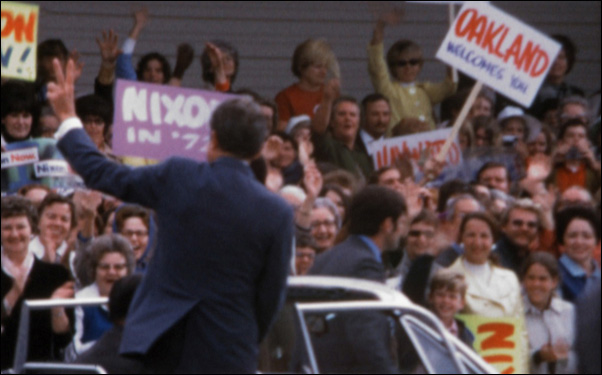In one of the news reports Penny Lane skillfully weaves into “Our Nixon,” an unorthodox portrait of our 37th president, his chief of staff H.R. Haldeman is introduced as being known for three things: “his conservativism, his crew cut and his “nonstop home moviemaking.” What made Haldeman so enamored of the personal 8mm camera is never really explored, but it becomes clear Nixon’s inner circle of he, John Ehrlichman and Dwight Chapin barely put the camera down between engineering the president’s ascent to the White House and the Watergate scandal that would ultimately bring him down, leaving behind a treasure trove of over 500 hours of recordings that was eventually confiscated by the FBI.
For the raw footage to simply be available now would make “Our Nixon” an event for history buffs all on its own, but out of the 36 usable hours of Super 8 film at their disposal, Lane, producer Brian L. Frye and editor Francisco Bello craft something far more accessible and emotionally appealing with a great deal of humor to boot. The tone is set from the start when Tracey Ullman’s hit single “They Don’t Know” begins to play over an opening credits sequence that presents Nixon and his staff as if they were the cast of “Happy Days” and they might as well have been since one of the implications of such unfettered access into their lives is that the image we previously had of them was forged from similar construction and roughly the same amount of time on our TV sets. There’s certainly fun to be had in humanizing such important historical figures, particularly in an administration as intimidating as the Nixon White House, but by positioning them as characters on a show that was one of the most watched ever, the film is revelatory in how it exposes the disconnect between the impenetrable public profile and the private interests of those who work in the Oval Office.
In broad strokes, the overarching resonance of “Our Nixon” would likely apply to any White House if the material was available because at this point any major facts about the Nixon White House has likely been sussed out between the scrutiny received during Watergate and the considerable amount of the White House Tapes and files that have been made available through the National Archives. There are little specific discoveries here and there – a jaw-dropping piece of footage from a White House concert where the member of a choir takes to the mic to say “God Bless Daniel Ellsberg,” the whistleblower who released the Pentagon Papers, before falling in line to sing for the President or the ever-present intrigue of which member of Nixon’s staff is filming, considering the curiosities that are captured, whether it’s the frivolous lingering on a bidet in a Roman hotel room during a diplomatic visit to the Vatican or the footage shot from a distance of Vietnam protests. Yet by bringing the two together — the newly uncovered clips with the copious private audio recordings already in the public sphere – the filmmakers fully contextualize the power structure that existed between the president and his advisers, a familial interoffice relationship where trust was implicit, but could turn on a dime from light and teasing to frighteningly serious over the most inconsequential of issues.
As a result, “Our Nixon” gently challenges what general public perception was and still is of the Nixon White House rather than hitting one over the head with it. Portraying Nixon as the same anxious, fearful man that’s become his rep, the film never fails to add an extra dimension to that image, particularly in how it parses out audio conversations where the president quizzes his staff on reaction to his latest speech, at once confirming the intense insecurity that’s become legend while diffusing any possible mythmaking through the sincerity of both its subject and of how it’s conveyed in the film. The addition of longform television interviews of each of the men doing the filming also prove to be sturdy columns for Lane to build her film around as a clever way to reinforce the duality of private and public lives, offering Chapin, Ehrlichman and Haldeman a chance to comment on major events in the Nixon presidency as they would as loyal lieutenants in order to cue up a peek behind the curtain either before or after.
“Our Nixon” never lags, which is incredible enough considering it’s made up entirely of archival footage, but what’s more impressive is how it pushes a narrative forward, particularly one that’s so fixed in the public’s memory, without resorting to shock tactics. What winds up being shocking is how ordinary historymaking can be.
“Our Nixon” doesn’t yet have U.S. distribution. It will next play New Directors/New Films at the Walter Reade Theater in New York on March 31st. A full list of upcoming screenings is here.




